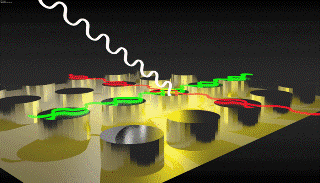May 8 2015
Aalto University researchers have discovered a breakthrough method of arranging magnetic materials into arrays of nanoscale dots that modify light polarization strongly and controllably upon reflection of the beam from the array.
 Aalto University Researchers have discovered a breakthrough method of arranging magnetic materials into arrays of nanoscale dots that modify light polarization strongly and controllably upon reflection of the beam from the array.
Aalto University Researchers have discovered a breakthrough method of arranging magnetic materials into arrays of nanoscale dots that modify light polarization strongly and controllably upon reflection of the beam from the array.
The results hold promise in improving optical components’ sensitivity to suit biosensing and telecommunication applications. In ferromagnetic materials, quantum mechanical interactions cause coupling of light and magnetization. These interactions can alter the material properties such as light intensity or polarization axis by generating magneto-optical effects.
The light and matter interact effectively at the nanoscale level. This serves as a basis for the plasmonic field, which explores the interaction of light with metal nanostructures. For visible wavelengths, a nano-sized, metallic nanoparticle acts as a tiny antenna.
The research was based on the phenomenon called surface lattice resonances where the radiation from the small antennas is in tandem in the form of an array. This can be achieved by arranging the magnetic nanoantennas on a length scale matching the incident light wavelength.
Collective oscillations take place upon strong interactions between the nanoparticles in periodic arrays. The members of the Quantum Dynamics (QD) research group at Aalto University have already reported similar behavior in noble metal nanoparticles.
The findings of the collaborative research between the Nanomagnetism and Spintronics (NanoSpin) group and QD have also revealed the presence of collective oscillations in magnetic materials. The changes in the light polarization of the ferromagnetic materials were greatly enhanced by surface lattice resonances, leading to the magneto-optical Kerr effect.
"A key finding of our research was that the frequency, that is the colour of light, for which this happens can be made different from the frequency where the purely optical effect is strongest. The separation of magneto-optical and optical signals was achieved by choosing a different distance between the nanoparticles in the two directions of the array," explained Professor Päivi Törmä.
The plasmon resonances observed in noble metals were difficult to achieve in ferromagnetic materials due to their high resistance that limit their optical activity. Therefore, ferromagnetic materials were not an obvious option for plasmonic applications.
"However, by ordering the nanoparticles in arrays and taking advantage of collective resonances, this problem was mitigated. Our result opens an important new direction in the research field that focuses on the coupling of light and magnetization at the nanoscale," said Professor Sebastiaan van Dijken.
The key for the project’s success is the collaborative effort of research groups who are involved in different fields. The researchers claimed that in-depth understanding on both the magnetism and optics at the nanoscale level is required to perform this research.
The experimental results have paved the way for the development of applications that are far beyond basic physics. The researchers used the electron microscopy tools at the Nanomicroscopy Center and the nanofabrication facilities in the Micronova cleanroom.
The study findings have been reported in the journal, Nature Communications.